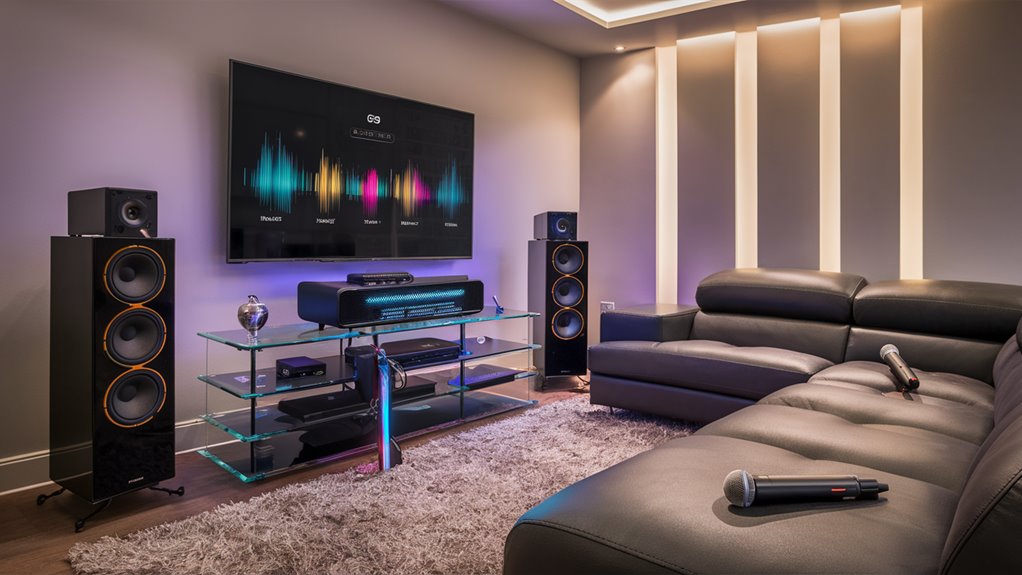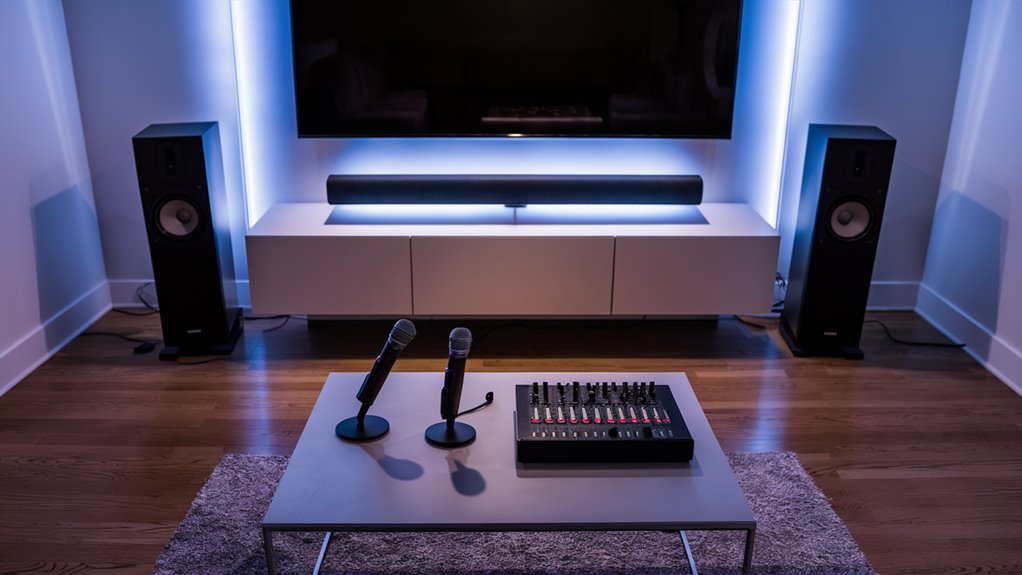Best Home Karaoke Setup: Top Gear for Your Living Room

Key Equipment Needed
To build a top-quality home karaoke system, you need four main parts that give you studio-like sound. The main karaoke gear includes a strong amp system (at least 100W+ RMS) which creates clear sound. Good cardioid mics with 250-600 ohm impedance catch your voice well with less noise. A small mixer with built-in EQ lets you adjust sound well, and a big screen (40-inch or more) gives you a great view.
Technical Details and Hookups
Your setup should have sound interfaces that work with 24-bit/48kHz. XLR connectors ensure top-quality sound transfer, and a fast-response monitoring system keeps your timing right when singing. These details make your karaoke sound real 호치민가라오케
Setting Up the Room and Acoustics
A smart room layout boosts sound quality and space for singing. Put speakers in a 60-degree setup and keep a 6-foot space clear for the best sound. Think about where you put soft items like couches to lower echo and keep voices clear. This setup makes a great space for both singers and watchers.
Managing Digital Songs
Build a big song list using common formats like MP4/CDG+MP3. Set up a good system to sort songs by type, singer, and how hard they are to sing. This helps you pick songs smoothly and switch easily during karaoke nights create unforgettable
Guide to Essential Karaoke System Parts
Main System Needs
A complete home karaoke setup needs several key parts to work well together. Start with a karaoke player – a special device or smart tool with karaoke apps. It handles your music files and shows lyrics in sync.
Audio Gear Details
What You Need for Sound
- Top-notch amp system (at least 100-watt RMS)
- High-quality speakers with a special bass speaker
- Good dynamic cardioid mics (2 or more) with XLR hookups
- Audio mixer that has:
- Two mic channels
- Built-in EQ settings
- Sound effects for echo/reverb
Screen and Connections
The screen setup needs a big TV or projector with at least 40-inch screen for clear lyrics. Essential wires include:
- XLR wires for mic hookup
- RCA or HDMI wires for sound/video
- Top-grade speaker wires matched to amp needs
Handling Sound
A compact mixer is central for controlling sound balance, letting you tweak music and voice levels well. The mixer should let each singer control their own sound while keeping the audio quality high through the system.
Choosing the Right Mic
The Best Mics for Karaoke
Key Mic Features for Great Singing
Choosing a karaoke mic, three main tech details make a big difference: pickup pattern, sound range, and impedance rate. Cardioid patterns are best for home karaoke setups as they focus on sound from the front and cut side and back noise. The best sound range is 50Hz to 15kHz, covering all vocal sounds while keeping the sound clear. Pick mics with an impedance of 250-600 ohms for best sound flow.
Dynamic vs. Condenser Mics for Karaoke
Dynamic mics are better for karaoke. They last longer, reduce feedback, and are easy to use without extra power needs. The Shure SM58 and Sennheiser e835 are great choices offering great value. For no-wire use, UHF systems that work in the 500-900MHz range are stable and resistant to interference better than VHF options.
Full Sound System Setup Guide

Must-Have Audio Parts
Any pro sound system needs three key parts:
- Audio Interface: A top USB interface with XLR inputs that supports 24-bit/48kHz
- Speaker System: Either powered monitors or unpowered speakers with an amp
- Audio Mixer: For detailed control over different audio sources
What You Need from an Audio Interface
A high-end USB audio interface is key for turning digital sound to analog. Important features include:
- Several XLR inputs for mics
- Quick-monitoring ability
- Pro-level AD/DA conversion at at least 24-bit/48kHz
How to Place and Set Up Speakers
Active Monitors
Studio monitors near you give the most accurate sound for home setups. Place them in an equal-sided triangle and at least 3 feet apart. They should be at your ear level when you sit in the main listening spot.
Passive Speaker Systems
If you use passive speakers, make sure:
- Your amp gives 50+ watts per channel
- They are 8-ohm matched
- Power is clean for clear sound
How to Use the Mixer
The mixing console is your control center. Key features should include:
- At least 4 channels
- Individual channel gain controls
- Three-band EQ per channel
- Built-in effects
- Aux send/return for extra effects
Getting the Sound Levels Right
Keep your audio smooth by:
- Adjusting mic input gain to peak at -12dB
- Making sure you have room in the sound mix for loud and soft parts
- Keeping an eye on the main output levels at all times
Song Library Handling
Management of Pro Karaoke Songs
Organizing Digital Music
Digital karaoke management needs careful organizing and exact control over important details for best performance. Set up a clear folder layout by sorting songs into different groups:
- By type
- Singer folders
- Sort by the decade
- By language
Keeping Track of Song Details
Use a standard way to name files (Artist – Title – Version) to find songs fast and easy. Good karaoke software keeps track of key info:
- Beat per minute (BPM)
- Key signatures
- How hard a song is to sing
- Signs for vocals or music only
- Track quality
- Lyrics style
Technical Needs & Storing Backups
Using common file formats (MP4 or CDG+MP3) ensures your songs play well. Put a strong backup plan in place:
- Save copies nearby
- Keep extra copies in the cloud
- Check your backups match often
- Make sure files are not broken
Getting the Best Performance
Quality checks keep your setup pro level:
- Make sure sound and video line up well
- Test if everything works together
- Check you’re following music rules
- Sort playlists by event type
- Update your song list so it’s easy to search
- Arrange tracks by what the crowd likes
Planning the Room
Planning Your Karaoke Room Layout
Best Setup for Space
Smart room layout planning is key to a great home karaoke setup, as how you arrange things impacts sound quality and how comfortable the singer is. Put main speakers at ear level and set them in a 60-degree angle from where you listen to get the best sound. A good room size for karaoke needs a 12×15 feet space for a well-balanced area for singing and watching.
Managing Echo and Furniture
Placing furniture well is key in handling room sound. Use soft items like couches and curtains to lessen echo while keeping a clear 6-foot space for singing. Put the screen at eye level, 4-6 feet from where you sing, so the lyrics are easy to see.
Setting Up Tech and Lights
Good cable management means safety and looks good in your karaoke area. Install sound and power lines along room edges using special channels to keep the space safe from trips. Use movable LED lights or track lights over the singing spot to make a clear stage area while keeping the light good for everyone watching.
